Thanks for your support! If you make a purchase using our links in this article, we may make a commission. And, as an Amazon Associate, I earn from qualifying purchases. See the full disclosure here.
Updated April 5, 2024
A common question that is asked in our Facebook Group is, Does an RV Battery Charge When Plugged into Shore Power? Fortunately, the answer is yes; your RV house battery will charge while it is plugged into shore power.
Your RV battery will charge when an external power source is connected and providing power to your RV. In addition to shore power, your RV battery will charge when your generator is running, the vehicle engine is running, or through solar panels.
But there is so much more to learn about RV batteries like:
- What Does Your Battery DO?
- What is the Best RV Battery?
- How to Protect Your RV Properly When Plugged into Shore Power
- RV Battery Maintenance
- How Much Do New RV Batteries Cost
- How to Install a New RV Battery
- and much more…
So read on to learn all about RV Batteries and Shore power!
What Is Shore Power?
RV shore power is when you plug your RV into an AC electrical grid. The available power you draw is available in amps and will vary from campground to campground. However, the most common RV connections are 30 amps and 50 amps.
Most RV campgrounds will have these hookups available to you. However, there are some dry campgrounds that do not have them. As a result, if you go to one of those campgrounds, you will need to make other plans for charging your RV battery.
If you visit a campground with electrical hookups, you will charge your RV battery with shore power.
Shore Power Versus Solar: Which Is Better?
Costs and situational usage aside, shore power always trumps solar power. This is true because unless there is a power outage that affects the campground, your source is as deep as you wish. Solar power is a fundamental building block behind successful and convenient boondocking or off-grid living, but only if you are willing to accept its weaknesses.
There is a lot more to it than just power availability and consumption, however. Solar panels are costly, but the overall savings, especially if your rig’s system is balanced, accrue over time. Solar power can even be used in conjunction with shore power, allowing the solar to run your rig until you need shore power for heavy-duty appliances.
Plus, the viability of solar-only is dependent on how elaborate your setup is, whether or not you’re using lithium batteries, and how much power you consume or don’t consume throughout the average day. Both have their uses, and solar offers a wider range of versatility than shore. But, in terms of raw power, shore is the better option.
RV House Battery or Engine Battery?
Depending on the type of RV you have you may have more than one battery.
Drivable RVs like Class A, B, and C RVs have at least 2 batteries. One battery starts the RV engine. Plugging your RV into shore power will not charge this battery. The second battery found in a drivable RV is the House battery.
The RV house battery powers all the stuff inside your RV like lights, appliances, etc. This battery will charge when plugged into shore power. It will also charge when you drive your RV, run your generator, or have it connected to solar power.
For towable RVs like travel trailers and 5th wheels, there is only one battery and that is the house battery. It will charge when you are plugged into shore power, a generator, or if you have solar panels.
In this article, we are only talking about the house battery in your RV.
What Does Your RV Battery Do?
Although this might seem like a simple question to those of you who are experienced with RVs and campers, it might not be to RV newbies. The house battery obviously powers something, but what does it power? Your RV battery or batteries provide your RV with a source of power when no external power is available.
The amount of power the batteries provide will be low in most cases. It will power the lights, water pump, and some small appliances, but not a whole lot more than that. Notably, it will not power your air conditioning or heating systems.
What Is the Best RV Battery?
Your RV may come with a battery or multiple batteries already installed. However, if you want to upgrade your RV batteries, you will have a few options available to you. Notably, you can purchase deep-cycle batteries or lithium batteries.
Deep Cycle Batteries
Deep cycle batteries are a type of lead-acid battery. They are similar to the ones you can find in boats or golf carts. A deep-cell battery is a lot like a car battery, and it uses the same chemistry to create and retain power. However, deep-cell batteries produce a steady amount of power over a long period of time. Whereas car batteries create a lot of power over a short period of time.
These types of batteries have a few subtypes for you to look out for. This includes wet cell batteries, absorbed glass mat batteries, and gel-type batteries. Each of them has different quirks and maintenance needs for you to manage.
Lithium Batteries
Lithium batteries are the second major type of battery for you to consider when looking for a new RV battery. They are an alternative to traditional lead-acid batteries that are offered in most modern RVs and campers. Many RVers that rig their RVs for solar power generation upgrade to lithium batteries because they offer a variety of benefits.
Notably, they are lighter and smaller, and they do not require the same amount of tedious maintenance. Additionally, these batteries have a longer lifespan than other battery types and are typically rated for 5000 cycles, as opposed to the 400 or so that can be expected of other batteries.
Unfortunately, the biggest downside to these batteries is that they are typically three times more expensive than the other batteries you might consider purchasing.
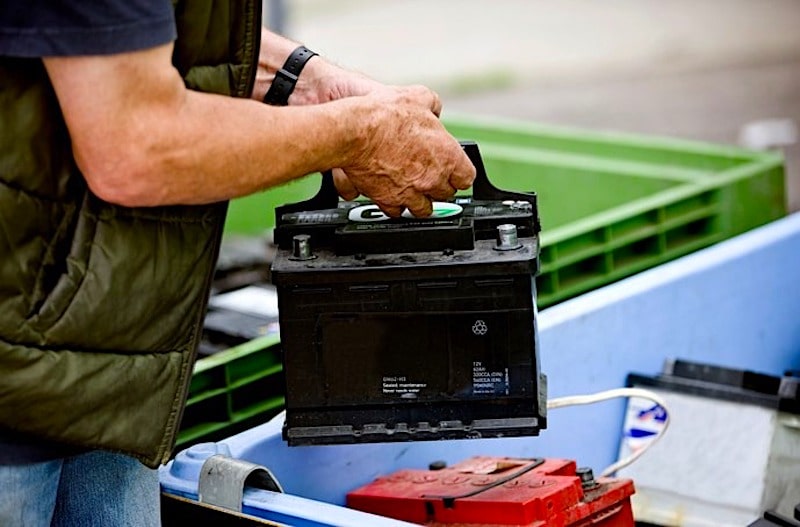
How to Tell the Difference Between Different Amp Options
When you get to your first campground, and you want to hook up your RV to shore power, you will need to know how to tell the difference between different amp options. Most campgrounds will have 50 and 30-amp hookups available to you. Fortunately, it is easy to tell the difference between the two.
50 amp plugins have 3 flat prongs and 1 round prong. Conversely, 30 amp plugins have 2 flat angled prongs and 1 round prong. There are also some campsites that have 20 amp plugins. These hookups will have 2 straight flat prongs and 1 round prong.
Can I Plug A 30-amp RV Into a 50-amp Plug?
You can only plug a 30A RV into a 50A plug with the right adaptor. A 50A setup will typically feature two sides, both of which offer 120v. The 30A adaptor will plug into one side and draw only 120v. It works the other way as well, with 50A plugs that only have access to 30A shore power.
Besides, without the adaptor, the male prong arrangement on a 30A plug simply won’t fit into the female arrangement on a 50A socket. The adaptor is necessary to make it work. It would be like trying to plug your home vacuum cleaner into the large socket over your washer and dryer in a residential home.
A 30A adaptor comes with a 50A male prong arrangement suited for connecting to shore power, and a 30A female socket for connecting to your RV plug. A 30A system operates on 120v and is equivalent to 3,600 watts, while a 50A system is equal to 6,000 watts.
How To Charge Your RV Battery When Hooking Up to Shore Power
Before you hook your RV up to shore power, you will want to make sure everything is safe and ready to go. It is easy to set up, but you will want to power down all your electronics before you hook your RV up to shore power.
Most of the time, it will not be a big deal if you leave electronics on, but issues can arise sometimes. Specifically, if the campground’s power source has faulty wiring, it might fry your electronics. You should be extra cautious if you are staying at smaller campgrounds because their systems might not get checked as much.
Additionally, RVs draw different amounts of power, depending on the size and design of the rig. As a result, certain RVs might not be compatible with every hookup you can find. So, it is a good idea to purchase a converter so that you can make sure that you can hook up your RV at every campsite you go to.
You will need two connectors for your RV depending on if your RV runs on 30 or 50 amps.
Adapters for 30 Amp RVs
You should keep both of these adapters on board so you can always be sure you can plug in at your campsite or at home.
1️⃣ You have a 30 amp rig and you have a 50 amp hookup you will need to purchase a 50 Amp Male To 30 Amp Female dogbone converter to be able to plug into the power outlet at your campsite like this one. (Yes – it is ok to plug a 30 amp RV into a 50 amp shore power source)
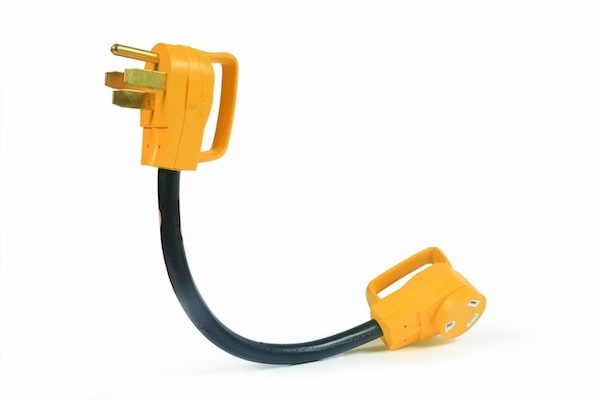
2️⃣ You have a 30 amp rig and only a 15 amp hookup (like if you want to plug in at home) – you will need to purchase a 15 amp male to 30 amp female adapter like this one.
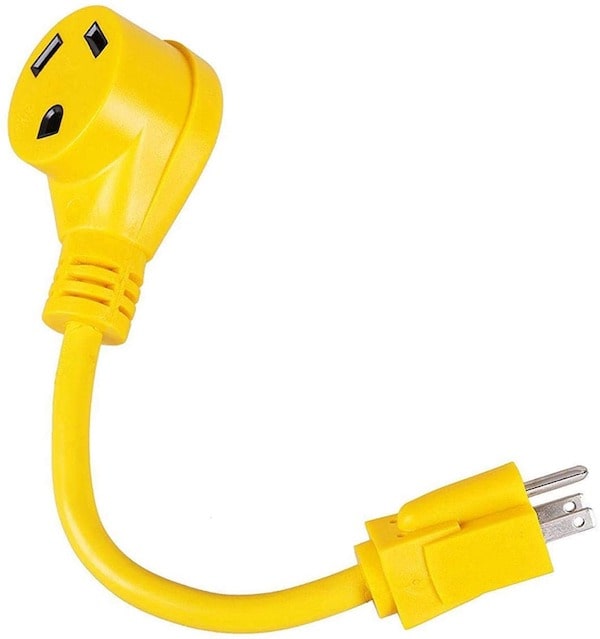
Adapters for 50 Amp RVs
You should keep both of these adapters on board so you can always be sure you can plug in at your campsite or at home.
1️⃣ You have a 50 amp rig and you have a 30 amp hookup you need to purchase a 30 Amp Male to 50 Amp Female dogbone converter to be able to plug into the power outlet at your campsite like this one.
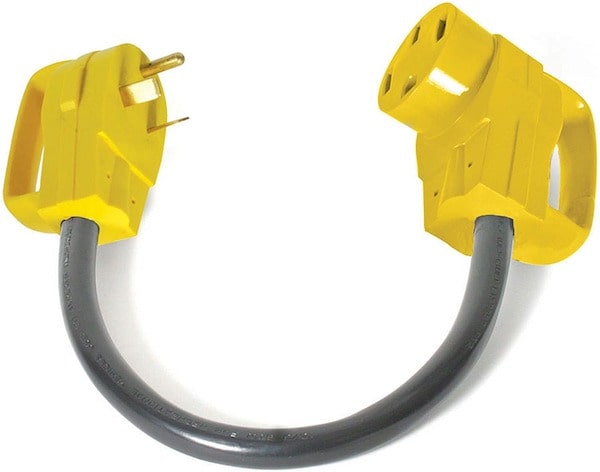
2️⃣ You have a 50 amp rig and only a 15 amp hookup (like if you want to plug in at home) – you will need a 15 Amp male to 50 Amp female adapter like this one.
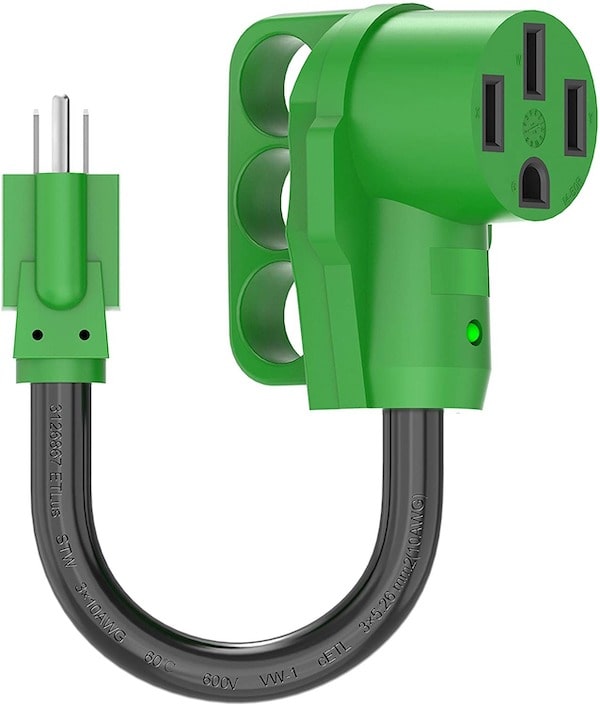
Is Campground Shore Power Safe?
As long as you follow the right safety precautions and use the right gear, campground shore power is every bit as safe as dealing with the plug next to your washer and dryer at home. For first-time RVers, the power pedestal may look a little intimidating, but it’s fine as long as you practice a few, basic safety precautions.
- Visually inspect the power pedestal, along with your connections and RV
- Make sure your adaptor is the appropriate one for your RV
- Turn off your RV’s circuit breaker before you plug in
- Plug your adaptor into the power pedestal first, followed by plugging your RV into the adaptor
- Switch the circuit breaker back off before you unplug from shore power
The above bullet points are easily incorporated into a routine and you’ll get used to doing things in order as you spend more time in your RV. As long as you play it safe and follow the above guidelines, there’s nothing to be concerned about.
Get Yourself A Surge Protector
The last thing you want is for everything in your RV to get fried because you did not take the proper precautions. If that happens, you will be stranded at your campsite waiting for some towing company to come and bring your RV to a shop to be fixed. That is not how you want to end your trip, so you should set yourself up with some surge protectors.
We use the Progressive Industries 30 Amp surge protector for our RV. It works great and protects everything in the RV like appliances, TVs, computers, cameras, and video gear! Here’s a picture of ours below.
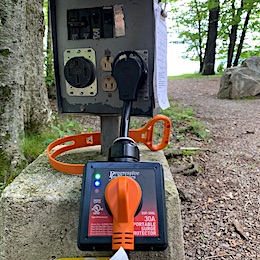
Can You Use Shore Power to Charge Your RV Battery at RV Campgrounds for Free?
If you have never been to an RV campground before, you are probably wondering if anyone can use the shore power that they provide. Fortunately, using the shore power is completely free, or you can assume it is built into the price that you pay to stay there.
So, if you need to charge your RV batteries, you do not need to worry about paying an extra fee to hook yourself up to shore power. There may be some RV campgrounds here and there that charge you for hookups, but for the most part, it will not be an issue.
5 RV Battery Maintenance Tips
Once you get the shore power situation figured out, you will want to make sure your batteries last as long as possible. Unfortunately, you will eventually need to replace your RV batteries. However, you can prolong this process by doing a few things to maintain them.
If you have lithium batteries, this basically does not apply to you at all because, as we mentioned earlier, they pretty much do not require any upkeep. However, if you are not lucky enough to have lithium batteries, you will need to keep on top of your RV battery maintenance. Otherwise, it will not matter if you know how to hook your RV up to shore power.
1. Maintain Electrolyte Levels in Flooded Cell Batteries
Over time, flooded cell batteries will lose water with each charge cycle. When this happens, the water needs to be replenished. You need to use distilled water to help reduce the chance of sulfation, or the formation of sulfate crystals that can occur when the battery plates are exposed to open air. You should check your batteries at least once a month to ensure that they are fully charged before you perform the necessary maintenance.
2. Clean Your Battery Terminals
This is something that can be overlooked by even the most experienced RV owners. You need to remove any corrosion that is built up in your battery terminals. You can use a mixture of one cup of baking soda to a gallon of water to clean the terminals.
There are also battery-cleaning products available that you can use. Ideally, you will use a toothbrush to scrub the terminals. You should check them regularly to ensure that there is no build-up of rust or corrosion. As soon as you notice something is discolored, take the time to clean it up.
3. Do Not Let Your Batteries Get Too Low
Letting your batteries get too low is not just bad with RV batteries; it is bad for any type of battery. This is something that most people do in their everyday lives. As a result, it can be easy to wait to charge or replace your RV battery until it is low on power.
However, this is dangerous because letting your battery get too low can increase sulfation. When they fall below 80 percent or 12.4 volts, sulfation can begin. As a result, you will want to make sure that you charge your batteries immediately after you use them.
4. Recharge Your Batteries as Much as You Can
This goes hand and hand with the section above, but you should recharge your batteries as often as you can. For example, if you discharge your battery to 50 percent every day, it will last twice as long as if you had discharged it 20 percent each day. However, you do need to be careful because overcharging your RV battery can have negative effects.
5. Remove Your Battery When Storing your RV
If you winterize your RV it is not a good idea to leave your RV plugged in all winter. You risk overcharging your battery which can cause serious problems for your battery or even start a fire!
Instead, you should store your battery in a warm place, like your basement, for the winter. Then be sure to attach it to a smart charger so it will keep your battery charged all winter without overcharging it.
PRO TIP: Be sure not to set your battery directly on the concrete floor. Set it on a piece of cardboard, which acts as an insulator.
Below is a Video from Mark Polk at RV Education 101. I have learned a ton from Marks Videos over the years and I have actually purchased many of his courses to I could learn how to properly operate and maintain my own RV. I highly recommend his courses since they are the most complete and thorough RV video training courses on the market.
Should You Get an RV Battery Monitor?
Getting your RV connected to shore power is great, but it will not be very helpful if you do not know when to connect it. Fortunately, you can get an RV battery monitor to check to see when it needs to be charged. An RV battery monitor will tell you exactly how much power your battery has left and how long you have until it needs to be charged.
There are several types of RV battery monitors on the market so it can be difficult to figure out what the best option is for you. Fortunately, most modern battery monitors include an LCD display that reads out all the information you might need from the monitor.
We don’t have a battery monitor. We just keep an eye on how quickly the battery drains and when it seems to be draining very quickly we replace the battery. This method works fine if you regularly maintain your battery.
How Much Does an RV Battery Cost?
If you own your RV for long enough, there will be a day when you need to replace your RV battery. When that happens, you might have concerns about the price. The cost of RV batteries varies significantly from one battery to another.
For example, a 12-volt, deep cycle lead-acid battery might cost you anywhere from $90 to $250$. And, a lithium RV battery can cost you anywhere from $600 to over $1,500 dollars. The two batteries we linked to in this paragraph are excellent batteries at the lower end of the price range.
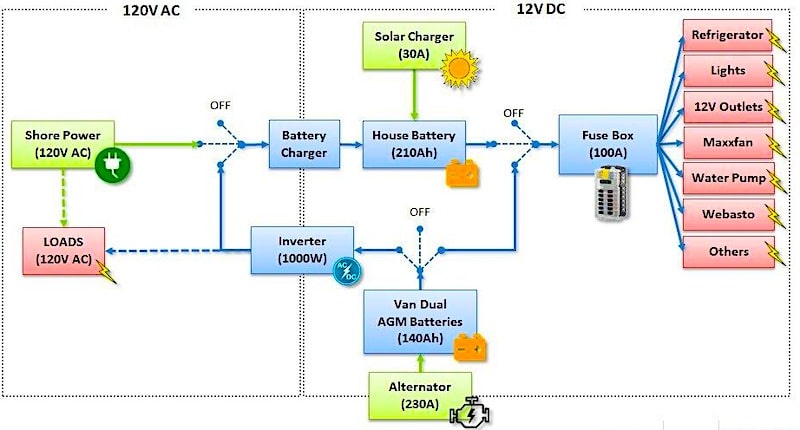
How Do You Install A New RV Battery?
Once you have your new RV battery, you will need to get it installed. To start, you will want to turn off all the objects that draw power from the battery. This includes minor appliances like the overhead lights. You should then make a note of where the current battery is located and then disconnect all the cables.
Start with the negative cables, then move on to the positives. Once everything is disconnected, clean the cables and the new battery’s terminals. You can then insert the battery and reattach the cables. Finally, install any hold-down hardware that might have come with your battery, and you will be ready for your first test run.
Never Run Out of Power by Using Shore Power to Charge Your RV Battery
After reading, we hope you have all the information you need regarding shore power and RV batteries. We know there is a lot of information to absorb, but it should all be helpful as you plan for your first RV trip. It is important to maintain your battery and to understand when it needs to be charged. Otherwise, you will need to replace it sooner than you might expect.
What type of battery did your RV come with? Were you familiar with shore power before you purchased an RV? Where do you plan on going for your next trip, and who will you be traveling with? Let us know in the comments!
Related Reading:
–Do I Need a Battery for My Travel Trailer?
–Can Solar Panels Really Power an RV Air Conditioner?
–5 Best Portable Solar Generators for Camping and RVing
–Will My RV Air Conditioner Run on 110 Electric Power
Mike Scarpignato – Bio
Mike Scarpignato created RVBlogger.com over five years ago in 2018 to share all we have learned about RV camping.
Mike is an avid outdoorsman with decades of experience tent camping and traveling in his 2008 Gulf Stream Conquest Class C RV and 2021 Thor Challenger Class A motorhome.
We attend RV Shows and visit RV dealerships all across the country to tour and review drivable motorhomes and towable trailers to provide the best evaluations of these RVs in our blog articles and YouTube videos.
We are 3/4-time RVers who created RVBlogger.com to provide helpful information about all kinds of RVs and related products, gear, camping memberships, tips, hacks and advice.


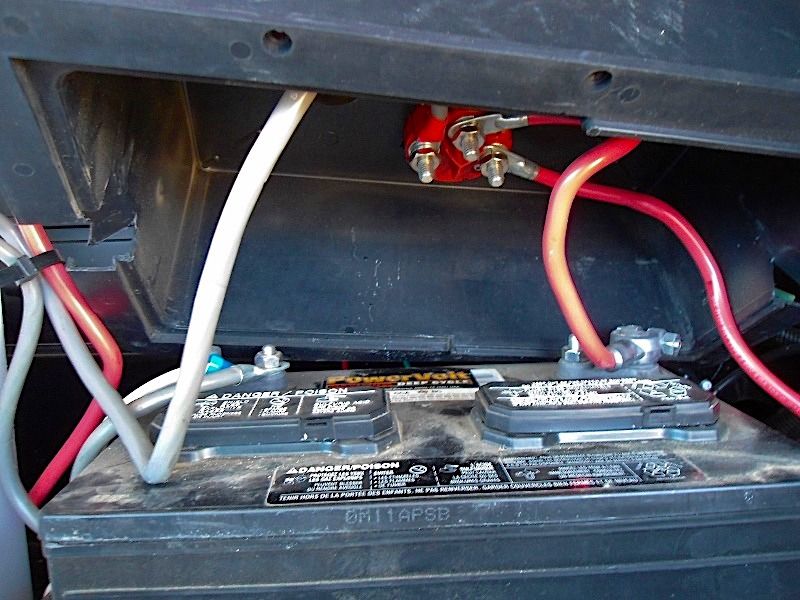
We’ve been plugged in to power for two days now and our battery is almost dead. I think the charger/ converter doesn’t seem to be doing it’s job. What should we do?
Hi,
Any suggestions on how to keep someone from stealing your surge protector?
Thank you!